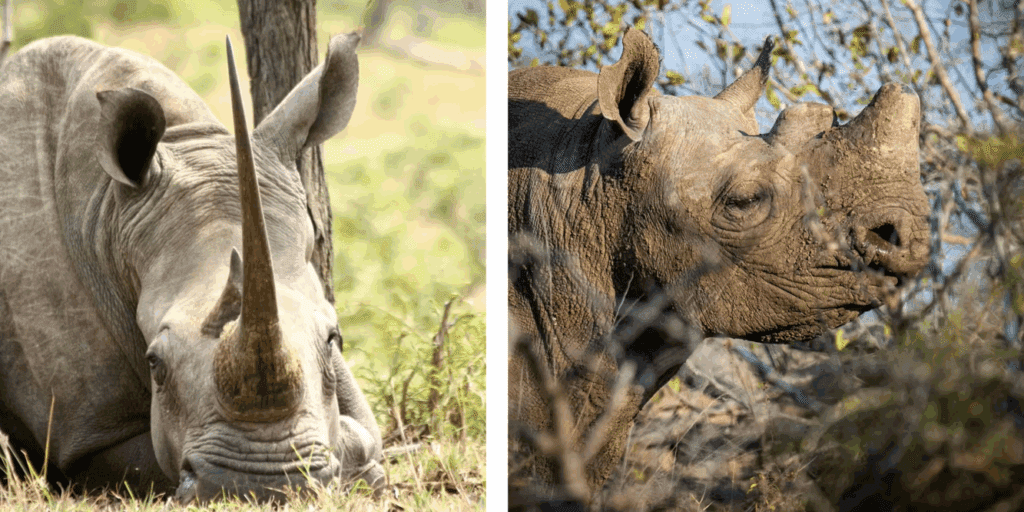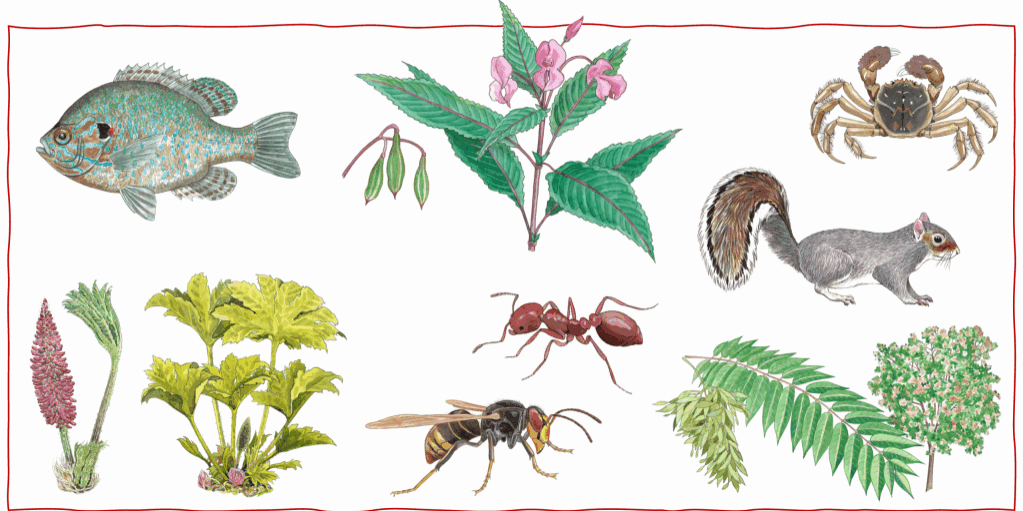There be dragons… in the Conservation Evidence database
In celebration of the Lunar New Year, we’ve collated eight potential conservation actions for dragons, with some evidence for their effects from the Conservation Evidence database. This is just a fraction of the available evidence; please explore the database for more!


1. Install tunnels/culverts/underpasses under roads/railways
A replicated study in 1996–1997 along three roadside verges in New South Wales, Australia (Norman et al. 1998) found that road underpasses were used by three lizard species and one snake species. Over nine months, two of three underpasses were used by eastern water dragons Physignathus lesueurii (3 photographs, tracks observed in one underpass) and eastern water skinks Eulamprus quoyii (3 photographs, tracks observed in two underpasses). One of the underpasses was used by lace monitor Varanus varius (8 photographs, tracks and scats observed) and diamond python Morelia spilota ssp. spilota (one photograph). In mid-August 1996 to mid-June 1997, a camera with an infrared trigger was set in three different underpasses of different sizes and design on a highway. A 1 m wide sand tray was also placed in each underpass. The authors note that animals that were small enough to avoid triggering the camera may not have been consistently recorded.
Photo: Paul Brian / Wikipedia / CC BY 3.0

2. Remove or control predators using lethal controls
A controlled, before-and-after study in 1990–1994 in mixed heath and dune habitat in Western Australia, Australia (Risbey et al. 2000) found that where cats Felis catus and foxes Vulpes vulpes, or just foxes were controlled, captures of reptiles did not increase. The number of geckos and skinks were similar in areas with cat and fox control, fox control only or no control (geckos: 1–2 individuals/trap grid; skinks: 2 individuals/trap grid). Dragon lizard numbers were lower in areas with greater predator control (cat and fox control: 2 individuals/trap grid; fox control only: 5 individuals/trap grid; no predator control: 7 individuals/trap grid). In areas with predator control, there was no clear change in reptile numbers from before control began (0–24 individuals/group/year) compared to the three years after control began (0–12 individuals/group/year). In 1991, a mainland peninsula was divided into three areas: one area (12 km2) where cats and foxes were controlled (using electrified fencing, poison baiting, or secondary poisoning by poisoning European rabbits Oryctolagus cuniculus, trapping or shooting); one area (120–200 km2) where foxes were controlled by baiting but cats were not targeted; and one area where no control occurred. Reptiles were monitored with six pitfall-trap and drift fence grids in each area (18 in total). Each grid had eight pitfall traps, 30–50 m apart. Sampling was conducted over three consecutive days in March–April and June–July in 1990–1994 in predator control areas and 1992–1994 in the area without predator control. Reptiles captured included dragon lizards, skinks, geckos, snakes, and a species of monitor lizard and blind snake but only species that could be toe clipped (dragon lizards, skinks and geckos) were included in analysis.
Photo: Jean and Fred Hort / Flickr / CC BY 2.0 (cropped and flipped)

3. Use prescribed burning in forest, open woodland & savanna
A replicated, site comparison study in 2001 in three sites within savanna woodlands in Queensland, Australia (Kutt & Woinarski 2007) found that overall reptile abundance was similar in burned and unburned areas, though the abundance of one species was higher after burning and another species abundance was lower after burning in combination with grazing. Overall reptile abundance was similar in burned (12–20 individuals/plot) and unburned plots (14–19), regardless of grazing practices. Of 18 species recorded, one dragon species abundance was higher in burned than unburned plots regardless of grazing and one ctenotus abundance was lower in burned than unburned plots, particularly when burning was combined with grazing (central netted dragon Ctenophorus nuchalis burned: 0.7–1.0 individuals/plot vs. unburned: 0–0.1; leopard ctenotus Ctenotus pantherinus 0–1 vs. 1–4). In January 2001, reptiles were monitored on three cattle stations (>20,000 ha each) in 29 one-ha plots that were either recently burned (within 2 years) or unburned (last burnt >2 years ago) and either ungrazed (paddocks where cattle were excluded) or grazed (4–8 cattle/ha). Burns were a mixture of prescribed burns and wildfires and all treatments took place over >2,000 ha areas. Reptiles were sampled using cage traps and pitfalls supplemented by day and night log rolling and litter raking.
Photo: Tim Rudman / Wikimedia Commons / CC BY 3.0

4. Provide supplementary food or water
A controlled, before-and-after study in 1990–1996 on two tropical islands in Komodo National Park, Indonesia (Walpole 2001) found that providing supplementary food at one location for Komodo dragons Varanus komodoensis resulted in larger numbers at the feeding site, but no evidence of an increase in the total population size. Results were not statistically tested. During four years of supplementary feeding (1990–1993), average daily dragon numbers at the feeding site were 16–19 dragons/day. After feeding ceased, average numbers were 13 in 1994 and six in 1995, by which point they were similar to numbers recorded at baited survey locations across the islands (3–4 dragons/day) in 1993–1995. Goat carcasses were provided two times/week from 1990 to August 1994 at a tourist viewing platform. In addition, the population was censused over 24 hours annually in October by securing a dead goat to permanent plots at 47 locations on Komodo island and 29 locations on Rinca island.
Image: San Diego Zoo Wildlife Alliance / GIPHY


5. Cease livestock grazing in grassland & shrubland
A replicated, controlled, before-and-after study in 1994–1997 in three sites of chenopod scrubland in South Australia, Australia (Read 2002), found that overall reptile species richness and capture rates were similar at ungrazed sites compared to those under short-term intensive grazing, but that capture rates of one species increased one year after intensive grazing. Overall reptile captures and species richness were similar in an ungrazed area and in paddocks with short-term intensive grazing, both immediately before and after grazing, and one year after grazing (results reported as statistical model outputs). Central netted dragon Ctenophorus nuchalis capture rates remained similar in the ungrazed area (0.5–0.6 individuals/plot) and grazed areas immediately before and after grazing (before: 0.3–0.6 individuals/plot, after 0.5–0.5), but were lower one year later in the ungrazed area (0.4) than in the grazed area (1.1–1.5). See paper for details of other species capture rates. Reptiles were surveyed in three sites: an ungrazed area and two adjacent short-term intensively grazed paddocks (20 ha each). Intensive grazing consisted of releasing 70–80 cattle into each paddock for 6–18 days in winter and summer 1995. Reptile surveys took place twice before, twice immediately after, and twice one year after grazing using drift fences with pitfall traps open for 10 days at a time (18 fence-trap plots in grazed and in 12 in ungrazed paddocks). Captured lizards were marked with unique toe clips.
Photo: Matt Clancy / Wikimedia Commons / CC BY 2.0

6. Breed reptiles in captivity
A replicated study in 2016–2017 in New South Wales, Australia (Hansson & Olsson 2018) found that Australian painted dragons Ctenophorus pictus bred successfully in captivity, and that hatching success was not affected by incubation temperature but was higher during the early breeding season. Females produced 1–4 clutches, with an average of 4 eggs/clutch. Overall hatching success was 60% (66 of 110 eggs) and hatching success was similar across all incubation temperatures (68% at 28°C; 56% at 30°C; 57% at 32°C). In addition, hatching success was higher for eggs laid earlier in the season (data presented at statistical model results). Wild-caught dragons were housed as breeding pairs in cages (50 x 40 x 35 cm) with a sand substrate, basking area, and sandy area for egg laying. Temperatures fluctuated between 15–25°C. Eggs were removed (110 eggs from 19 females) and placed in individual plastic cups (125 ml) in moist vermiculite (1:5 ratio with water by volume), and the cups were sealed with plastic cling wrap and a rubber band. Eggs from each clutch were split evenly between three incubation temperatures: 28, 30 or 32°C (110 eggs overall). Eggs were checked daily and those that failed during incubation were removed.
Photo: David Cook / Flickr / CC BY-NC 2.0

7. Remove or control predators using fencing and/or aerial nets
A controlled, before-and-after study in 1990–1994 in mixed heath and dune habitat in Western Australia, Australia (Risbey et al. 2000) found that a fenced area with cat Felis catus and fox Vulpes vulpes control had similar numbers of geckos and skinks but fewer dragon lizards than unfenced areas with and without fox control. The effects of fencing and predator control cannot be separated. The number of geckos and skinks were similar in the fenced area (with fox and cat control) and unfenced (fox control or no control) area (geckos: 1–2 individuals/trap grid; skinks: 2 individuals/trap grid). Dragon lizard numbers were lower in the fenced area with fox and cat control (fox and cat control: 2 individuals/trap grid) compared to unfenced areas with fox control (fox control only: 5 individuals/trap grid) and unfenced, no control areas (no predator control: 7 individuals/trap grid). In areas with predator control, there was no clear change in reptile numbers from before control began (0–24 individuals/group/year) compared to the three years after control began (0–12 individuals/group/year). In 1991, a mainland peninsula was divided into three areas: one area (12 km2) where cats and foxes were controlled (using electrified fencing, poison baiting, or secondary poisoning by poisoning European rabbits Oryctolagus cuniculus, trapping or shooting); one area (120–200 km2) where foxes were controlled by baiting but cats were not targeted; and one area where no control occurred. Reptiles were monitored with six pitfall-trap and drift fence grids in each area (18 in total). Each grid had eight pitfall traps, 30–50 m apart. Sampling was conducted over three consecutive days in March–April and June–July in 1990–1994 in predator control areas and 1992–1994 in the area without predator control. Reptiles captured included dragon lizards, skinks, geckos, snakes, and a species of monitor lizard and blind snake but only species that could be toe clipped (dragon lizards, skinks and geckos) were included in analysis.
Photo: Marcin / Flickr / CC BY-NC-ND 2.0

8. Create artificial refuges, hibernacula and aestivation sites
A replicated, site comparison study in 2000–2001 in a site of grassland with wooded patches in Victoria, Australia (Michael et al. 2004) found that more reptiles tended to use old log refuges compared with new log refuges. Three species were found more commonly under old logs compared to new logs (tessellated gecko Diplodactylus tessellatus: 6 individuals in old logs vs 2 in new logs, Boulenger’s skink Morethia boulengeri: 12 vs 6; curl snake Suta suta: 38 vs 7). Three species were found in similar numbers under old and new logs (striped legless lizard Delma impar: 1 in old logs vs 2 in new; olive legless lizard Delma inornate: 6 vs 9; Grey’s skink Menetia greyii: 23 vs 9) and two species were found under only one log type (bearded dragon Pogona barbata: 1 under new log; eastern brown snake Pseudonaja textilis: 2 under old log). An area of 3,780 ha was marked into 91 quadrats and in May 2000, and 12–20 logs (old fence posts) were placed in every quadrat (total of 1,131 log refuges). An additional 271 fallen fence posts that had lain in situ for 15 years were also monitored. Monthly surveys took place between June 2000 and January 2001.
Photo: Arthur Chapman / Flickr / CC BY 2.0

All actions and summaries are from the Reptile Conservation synopsis:
Sainsbury K.A., Morgan W.H., Watson M., Rotem G., Bouskila A., Smith R.K. & Sutherland W.J. (2021) Reptile Conservation: Global Evidence for the Effects of Interventions for Reptiles. Conservation Evidence Series Synopsis. University of Cambridge, Cambridge, UK.
They are reproduced under a CC BY 4.0 license.



